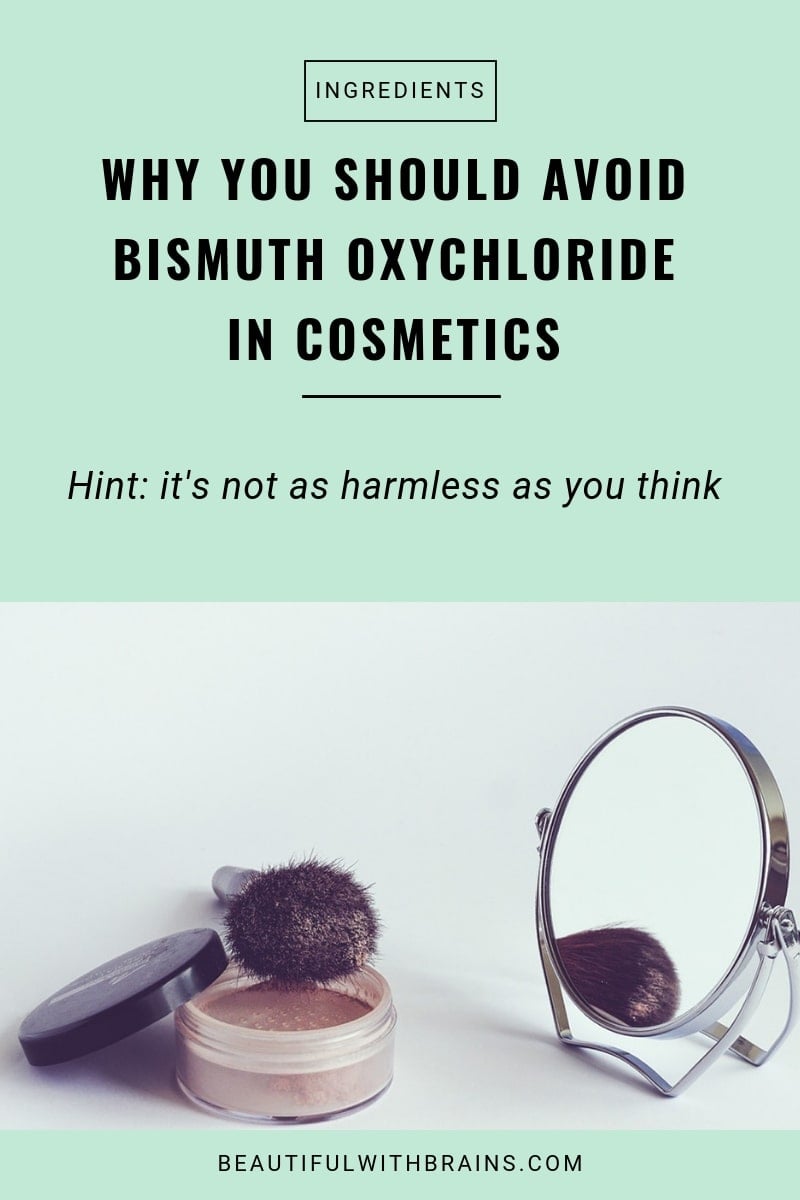
Did you jump on the mineral makeup bandwagon only to see your face break out in a horrible rush?
WTH? Wasn’t this stuff supposed to be safer?
Not really. Dangerous stuff is lurking in there too.
When it comes to mineral makeup, the culprit is usually Bismuth Oxychloride.
What Is Bismuth Oxychloride?
Bismuth Oxychloride is derived from the metal bismuth, a natural component of the mineral bismoclite. Problem is, bismuth is rare in nature, so no one bothers to mine it to put it in cosmetics (it’d cost a fortune if they did!).
Instead, the Bismuth Oxychloride that is lurking in your cosmetics is a by-product of copper and lead refining that’s then mixed with chloride and water (by the way, the whole thing goes through a strict refining process to make it safe for use in cosmetics).
Once finished, Bismuth Oxychloride looks like a greyish/white powder with either a pearl or diamond finish.
What Does Bismuth Oxychloride Do In Mineral Makeup?
I mean, it’s obvious this stuff is not even that natural! So, why is it used in mineral makeup (and traditional makeup, for that matter)?
A few reasons:
- It binds products together: It gives makeup products texture and smoothness and helps them adhere to the skin better.
- It gives products their finish: It can impart either a matte or shimmering finish to cosmetics.
- It’s refractive: When the light hits it, it helps reduce the appearance of fine lines and wrinkles.
Add to that its cheap price and it’s easy to see why beauty brands love it. Consumers, on the other hand, not so much…
Want to know what ingredients you really need to avoid in your skincare products? Sign up to the newsletter below to receive the “Skincare Ingredients To Avoid” cheatsheet:
Why Is Bismuth Oxychloride Bad For Skin?
Bismuth Oxychloride is super irritating. It causes:
- Allergies
- Irritations
- Itchiness
- Redness
It’s its unique crystalline nature that’s causing the problem. These crystals have sharp edges that poke at the skin, irritating it. They can also get stuck in the pores, causing breakouts.
I’m not saying that everyone who uses Bismuth Oxychloride will suffer this fate. I’m one of those lucky ladies with resilient skin who can easily tolerate Bismuth Oxychloride.
But, even I prefer to avoid it. With so many alternatives these days, why still still use a common irritant and allergen?
The Bottom Line
Bismuth Oxychloride is a common ingredient in mineral makeup. It’s also a common irritant and allergen. If your new mineral foundation gave you a bad rash, this is probably the culprit. Stay away!
Do you use or avoid products with Bismuth Oxychloride? Share your experience in the comments below.

I avoid it like plague because I am allergic to it. It does give a pearly sheen, which is dreamy on the skin of a lot of mineral makeup users. However, that effect can be duped by using a few other ingredients, which are a lot safer on your skin.
Dao, I know you’re allergic and that’s too bad. But I agree with you. There are other ingredients that can give the same effect as BO but won’t cause problems to a lot of people so companies should start using them more.
Like Dao, I avoid bismuth at all costs. Bismuth + my skin = breakouts. Eeek!
Fabulessbeauty, that’s too bad. BO is a common allergen and irritant and can cause problems to lots of people. 🙁
I haven’t had any problems with Bismuth Oxychloride, but I know a lot of people do! It’s crazy that it’s in so many mineral makeups (although I know a lot of companies are getting rid of it now). It’s ironic and unfortunate that it’s in so many products that are called “natural” alternatives to regular makeup.
Jeni, I agree. It’s good that some companies are finally getting rid of this ingredient but it’s still in too many products imo. It seems to be more traditional companies like MAC or Elizabeth Arden that put BO in their mineral makeup products which usually aren’t mineral at all..
I avoid it because it makes me itch and breakout in pimples!
Tammy, oh no! I’m sorry to hear that.